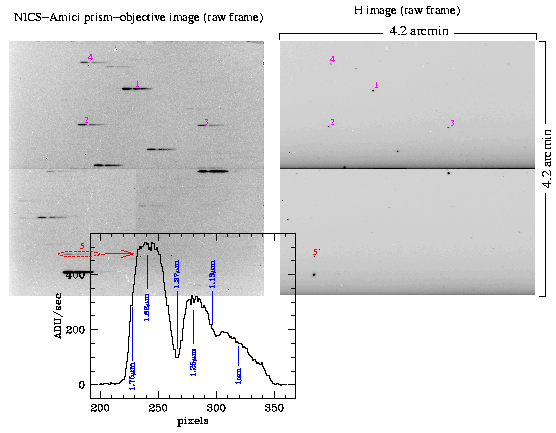Infrared prism objective available at TNG
The infrared multi-mode instrument of TNG, NICS, can now perform low resolution spectroscopic observations using the Amici prism in slit-less mode. The frame format is similar to classical prism-objective images, an example is given in the figure below.
Characteristics and performances
| Field of view | 3.5 x 4.2 arcmin | |
| Spectral coverage | 0.9-1.75 microns | Long wavelength cutoff set by SW filter |
| Dispersion (Å/pixel) | 100 (H), 80 (J), 55 (1mic) | |
| Resolving power | 40 for 1" seeing | Scales with 1/seeing |
| Zero points | 18.4 (H), 18.5 (J), 18.4 (1mic) | mag for 1 ADU/sec/pix on 1D extracted spectrum |
| Lim. magnitude (10 sigma) | 17.0 + 1.25 log(Tint/20min) - 1.25 log(seeing/1") + 1.25 log(Npix) | |
|
where:
The limiting magnitudes (10 sigma) are in Vega units and are the same in the H, J and 1mic bands Tint is the total integration time Npix is the number of rebinned/smoothed pixels along dispersion in the 1D spectrum. |
||
Data acquisition
The instrument setup corresponds to the low-resolution mode with the Amici, slit-less and SW attenuator. The array should be set to detector integration time DIT=30sec and NDIT=3. To correct for the spectral overlapping of nearby objects it is convenient taking 2 series of prism-objective frames at position angles PA=0 and PA=90 degrees. An H image should also be taken to better recognize and position the objects in the field.
Data reduction
The 2D frames can be sky-subtracted and aligned as normal images using e.g. the snap reduction package. The extracted spectra can be wavelength calibrated using the Amici look-up table described in the NICS documentation and shifting the pixel vector by, to a first approximation, (Xcen-530); Xcen being the X-position of the object in the non-dispersed image. The calibration can be then refined by matching the 1.75 micron cutoff and the deep atmospheric absorption band at 1.37 microns. A first-order flux calibration can be obtained using the above zero-points which, given the good instrumental stability, are not expected to vary by more than +/-0.1 mag even on long time scales. More accurate flux calibration can be obtained by separately measuring standard stars. The atmospheric absorption features can be corrected using spectra of other stars in the same field/image.


